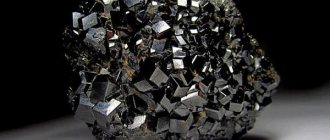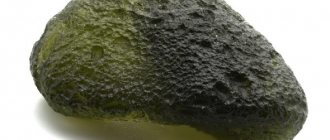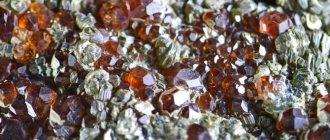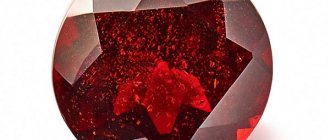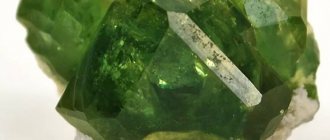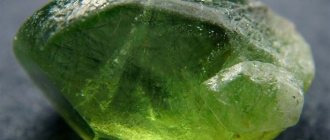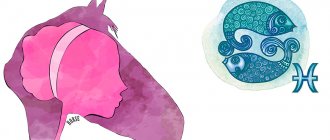History and legends of origin
From the ancient Greek language the word “pyrope” is translated as fire-like. The stone is considered the patron saint of the god of war, Mars.
In Mongolian legends, stones are considered frozen fragments of volcanic fire, as well as frozen drops of dragon blood.
Pyrope crystals are perfect for cutting and making decorative inserts in jewelry.
A scattering of stones in a rock
In 1028, the scientist Biruni wrote a book about minerals, where a clear description of the fire garnet was given, as well as the beneficial properties of the gem.
The shine of pyrope misleads people, since since ancient times the mineral has been confused with ruby and tourmaline - stones with a similar shade.
Pyrope garnet jewelry
Pomegranate has been known since ancient times. Even then, in Egypt, Persia, Ancient Rome and Greece, its crystals were used in jewelry. Vases, bowls, and signets were decorated with pyrope. They inlaid silver and gold dishes, and warriors wore swords, shields and belts decorated with garnets.
Today, pyrope is used to decorate bracelets, earrings, brooches, rings, and, of course, beautiful garnet necklaces and necklaces. Pyrope goes well with silver, gold and platinum.
Place of Birth
Large deposits of pyrope:
- Sri Lanka;
- South America;
- USA;
- Czech Republic.
Purple pyropes were found near the Tanzania-Kenya border and were later called rhodolites.
Brooch with pyrope inserts
In India and Brazil, specialists have opened a mine for the extraction of purple stones. In appearance they look like grape juice, which is why they got their name “grape pyrope”.
In Russia, the precious stone is mined in Yakutia, Khakassia, and the Irkutsk region.
High quality crystals are found in the Czech Republic - “Bohemian garnet”, “Bohemian ruby”, as well as on the island of Sri Lanka. The main distinctive feature is that they contain inclusions of rutile, and when cut, “cat’s eye” and “star” effects are observed.
How to care for stone
As a durable stone, pyrope is easy to care for.
To clean it, a soap solution is suitable, in which the product is immersed for half an hour, after which it is cleaned with a soft brush. The stone is then rinsed with cool running water and polished with a dry cloth. In addition, a saline solution is used for these purposes, which is prepared from one teaspoon of salt per liter of water. The product with pyrope is left in it for 8-10 hours, after which it is washed with running water and wiped dry. To restore pyrope to its beautiful shine, the stone can be wiped with a cloth soaked in alcohol.
Physicochemical characteristics
Pyrope has a bright, rich fiery color. The shade directly depends on the quality of the mountain impurities that make up the mineral. Chromium gives pyrope its red color; therefore, the higher the concentration of the element in the gem, the richer the shade of the stone.
We recommend reading: Rhodonite (Pink spar) - the magic of the dawn stone
| Formula | Mg3Al2(SiO4)3 |
| Impurity | Fe, Mn, Cr |
| Color | Blood red, orange, red, purple, pink, dark red |
| Stroke color | White |
| Shine | Glass |
| Transparency | Transparent, translucent |
| Hardness | 7,5 |
| Cleavage | No |
| Kink | Uneven |
| singonia | Cubic |
| Density | 3.65 - 3.84 g/cm³ |
Natural crystal shapes and cuts
The stone has a glass-like luster, which gives the desired shimmer of edges after cutting. A hardness of 7.5 units implies processing and grinding, which does not require much effort. Therefore, craftsmen are happy to use the stone to make jewelry.
Pyrope stones found in nature often resemble spheres in shape. This suggests that the crystals did not form clear edges. Like garnet, pyrope exhibits a cubic system. That is, an elementary lattice cell is created by three identical vectors that are perpendicular to each other.
The most common crystal shapes are dodecahedrons, rhombuses or trapezoids. Taking this natural factor into account, craftsmen do not hesitate in choosing cuts and use the simplest ones. The natural facets of pyrope are taken as the basis. The result is stunning pendants that retain the maximum from nature.
However, too dark red pyropes are processed in a special way. The stone is made concave at the top and bottom. The main goal is to reduce the thickness of the crystal. And then the mineral transmits light better.
Varieties and colors
Pyrope has a dark red hue.
Rarely found examples of the following colors:
- orange;
- pink;
- purple;
- blood red;
- fiery red;
- brown-black.
Sometimes colorless crystals are found in nature. Such specimens are rarely used in jewelry; they are mainly used in industry as an abrasive material.
In the Middle Ages, the found crystal was first called “pigeon’s blood”, and in the 17th century the mineral acquired the official name - “stone from Bohemia”.
Colors
The main color is always red. The most popular are wine-colored stones (relatively dark, with a slight hint of pink or purple). The most common are blood red and tan stones. There are also several other colors:
- purple;
- brown-red;
- pink;
- brown;
- dark burgundy.
Dark minerals are often used in jewelry. It is believed that such representatives look especially impressive and have the most powerful impact. Dark brown, almost black specimens are rare. Of particular value are minerals with the effect of alexandrite, which change color depending on the lighting.
Areas of use
Pyrope gemstone is very convenient to process. The mineral is widely distributed, which is why it is considered an inexpensive stone.
Uncut stone
In jewelry, experts prefer to use gems mined in the Czech Republic. They are also called “Bohemian grenades”. The first jewelry appeared in the 10th-11th century.
Some specimens of pyropes are similar in appearance to rubies. Therefore, jewelers prefer to call it Cape, Arizona ruby, thereby increasing the price of the finished product.
Characteristics of the stone
The stone is called pyrope garnet because it contains a high concentration of iron, magnesium and chromium (about 50% magnesium oxide).
- All colors of pyrope are characterized only by red shades.
- Transparency can vary quite a bit. There are both translucent minerals and completely transparent ones. Pyrope resembles spinel, ruby or the rather rare tourmaline.
- The stone has high hardness.
Czech pyropes are considered the most popular. Based on the name, they are mined in the central Czech Republic. All varieties of Bohemian pyropes (Czech) have long been used to make jewelry. This does not prevent them from being particularly popular among collectors.
There are no special industrial sites for pomegranate mining in the CIS countries. Trout crystal is often found only in Crimea. It is presented in green color with small admixtures of pyrope.
Cost and where to buy
The price directly depends on the quality, color and method of processing the gemstone. The most expensive is the pink stone.
Jewelry made with inserts of small minerals has a low cost. The average cost of jewelry depends on the design, the number of cut stones and varies approximately from 1.5 to 2 thousand rubles. In specialized stores, such a product can cost from 5,000 to 15,000 rubles.
Pyrope is considered an inexpensive stone, so finding a fake on the jewelry market is rare.
Bohemian crystals sold in tourist places in the Czech Republic are mainly of synthetic origin. The deposits of this region have already been depleted, for this reason natural minerals are becoming rare in this place.
We recommend reading: Bull's Eye - a stone of good health for Roman soldiers
Such different grenades
Known since ancient times... Compared to many other precious stones - relatively good availability (although not as good as is commonly thought)... Opportunity to find the purest examples... Remarkable in their natural nature - almost never subject to refinement... Relatively inexpensive ( if small) and competing in value with diamonds, if large or of the rarest varieties... Not the hardest, but due to their non-fragility - very easy to work with and loved by jewelers all over the world... With a rich palette of colors (until recently it was believed that they could not be only blue)...
Everyone knows them... And not everything is known about them yet, and they continue to surprise us!
GARNETS The name “garnets” is quite universal in the sense that it is applied to a whole range of related minerals... Almandine, Spessartine, Pyrope, Grossular, Andradite... There is also Uvarovite and several other minerals of the garnet family, which do not form large crystals and with jewelry- unknown from a gemological point of view. In the jewelry field, various varieties of garnets were “stuck” with trade or historical names, which became so commonplace that gemologists adopted these names as gemological terms (which greatly angered mineralogists). Here we will briefly go through the jewelry and gemological series of garnets...
General gemological dossier of garnets: Color range: All colors of the visible optical spectrum Chemical formula: L3M2(SiO4)3 (L and M are various metals that determine the mineral appearance of garnet) Refractive index: 1.74 - 1.89 Hardness: 6.5 - 7.5 Density: 3.60 - 4.20 Crystal structure: Cubic Origin: Europe, Asia, Africa, North America, South America (Australia, Antarctica - commercially significant deposits have not yet been discovered) And now let’s look at our favorite garnets by "bones". That is, by components. An important detail - as a mineral species, none of the various garnets are practically found in nature in their pure form! Any garnet is always a mixture of at least two, and often more, varieties of minerals. 1. Pyrope garnet. Color range: Red, orange-red, purple-red ranging from pink to brown Chemical formula: Mg3Al2(SiO4)3 Refractive index: 1.73 - 1.76 Hardness: 7.00 - 7.5 Density: 3.65 - 3 .80 Crystal structure: Cubic Origin: USA (4 corners), Czech Republic, Italy (Dora Maira massif) Contrary to popular belief, pyropes are one of the rarest garnets. Known for its deposits in the Czech Republic since late antiquity, Czech pyropes are rare gemstones that were long available only to the wealthy nobility. And in our time, they have become inaccessible to almost anyone! The deposits in the Czech Republic have been exhausted, there is almost no mining, and the garnets in numerous shops in Prague are synthetic. Natural pyropes are only in extremely rare cases larger than 1 carat! With all the richest selection of garnets, I cannot show a single photograph of real Czech pyrope - we do not have such stones. In the USA, mainly in Arizona, a variety of pyropes, chromium-pyropes, is found in small quantities. These stones are distinguished by their exceptional “redness”, the amazing method of their extraction and rarity. A separate material will be devoted to them. 2. Just garnet - almandine garnet. Color range: Orange-red, rarely from purple red to purple violet (most often very dark tones) Chemical formula: Fe3Al2(SiO4)3 Refractive index: 1.78 - 1.81 Hardness: 7.5 Density: 3.95 - 4 ,20 Crystal structure: Cubic Origin: South Africa, Germany, USA, Russia (commercially insignificant deposits have been discovered in more than 30 countries) Almandines are the same garnets that we have long and habitually called simply garnets. which are probably in every home, every woman. Inexpensive, widespread stones, sometimes even found in the form of multi-carat “cobblestones”. Thanks to their excellent polishability, these garnets are beautiful, but their main drawback is their dark tone.
3. Rhodolite Color range: Red, purple red, red purple Chemical formula: (Mg, Fe)3Al2(SiO4)3 Refractive index: 1.75 - 1.77 Hardness: 7.25 Density: 3.74 - 3.94 Crystal structure: Cubic Origin: Brazil, East Africa, Zimbabwe, Madagascar, Sri Lanka, India The name rhodolite goes to garnets, which are a mineral mixture of pyropes and almandines. Rhodolites became a separate type of precious garnets due to the fact that they are lighter than all their red “relatives”. Due to their color, rhodolites can sometimes even be confused with rubies! Actually, during examination, rhodolites are separated from their brothers - pyropes and almandines, by their lighter tone. Among all red garnets, due to their relative “lightness” and the presence of purple and violet undertones, rhodolites have long been the most popular variety of red garnets. Often growing to impressive sizes, and at the same time possessing exceptional purity, large rhodoliths become a very significant “receptacle” for money.
4. Garnet with the effect of changing light (Alexandrite effect) Color range: Green, blue - purple, red Chemical formula: (Mn,Ca)3Al2(SiO4)3 Refractive index: 1.78 - 1.81 Hardness: 7.00 - 7.50 Density: 3.80 Crystal structure: Cubic Origin: Tanzania, Kenya, Madagascar, Sri Lanka One of the rarest types of garnets, with an exceptionally strong color changing effect, is classic spessartite with a small proportion of grossular. Small (0.1%) chromium impurities are probably responsible for the “alexadrite” effect. An amazing stone that disproved the claim that garnet cannot be blue. It turned out - maybe!!! The only precious stone that has a color-changing effect similar to alexandrites both in color and in strength. Blue or green during the day in natural light, garnet turns bright purple or red in the evening under lamps or candles. But this garnet can boast of something else that even alexandrite does not have! The color of the pomegranate changes very slowly, smoothly from blue-green in the morning to purple-red in the evening, even in sunlight! Unfortunately, this effect is more noticeable the closer the observer is to the equator. In Russia, this can probably be observed, at least in a slightly noticeable form, only in the very south and high in the mountains. There is no constant mining of garnets with the effect of changing color. They are sometimes found, and then a year or several may pass until a new “batch” is revealed to the human eye. They are sometimes found in Ceylon, but the effect of color change is rather weak, and there are almost no pure stones. Tanzania and Kenya also do not produce the most “strongly spectacular” stones, although they are very clean. For lovers of such pomegranates, Madagascar has become a unique place, or more precisely, several rivers near the town of Bekili. It is from there, from alluvial deposits along the banks of rivers and streams, that the most fantastically beautiful “Alexandrite” garnets come to us, which have already become a very effective budget replacement for alexandrites - yet they cost ten, or even dozens of times, with comparable quality below..
5. Pomegranate Malaya
The name Malaya pomegranate comes from a consonant word in the Swahili language, meaning “changeable”, “unfaithful”... Color range: Greenish yellow, yellow, yellowish orange, orange, orangish red, red, reddish purple, purplish red. Refractive index: 1.73 - 1.81 Chemical formula: [Mg,Mn]3Al2(SiO4) Hardness: 7.0 - 7.5 Density: 3.65 - 4.20 Lattice type: Cubic Origin: Kenya, Tanzania , Sudan, Madagascar. Malaya is the name given to a group of gemstones from the garnet family. Malayas may share the same color as other better-known members of the garnet family, but differ from all other garnet varieties in their gemological characteristics. Originally a mixture of spessartine and pyrope with a small proportion of grossular, malaya garnets exhibit color and gemological characteristics that overlap with those of grossularite, rhodolite and pyrope. Some malaya garnets are capable of noticeably changing color when changing from daylight to artificial light, which is likely due to the presence of trace amounts of chromium and/or vanadium. Whether the known garnets with a strong "Alexandrite" color-changing effect can be classified as Malaya garnets should be clarified by ongoing research. The only deposits of Malaya garnets of commercial importance are in the Umbra Valley of Kenya, northern Tanzania, southern Sudan and southern Madagascar in the Bekili region. Large crystals are extremely rare, and most of the raw material is very small (up to 1.0 -1.5 carats). Malaya garnet is sometimes very difficult to distinguish from one of the forms of grossular - hessonite. This is possible because both varieties of garnet can have exactly the same color, and the refractive index and density values overlap greatly. Specific identification of malaya garnet (pyrope-spessartine garnet) usually requires chemical analysis. Malaya garnet contains significant amounts of Mn and Mg with traces of Fe and Ca, while grossular hessonite contains no Mn and Mg, but contains significant amounts of Ca. The simplest and most effective method is spectral analysis. The features of the absorption spectrum for malaya garnet are mainly due to the absorption lines of Mn2+ and Fe2+. Strong absorption lines at wavelengths of 503, 610 and 687 nm correspond to divalent iron ions, and a line at a wavelength of 483 nm corresponds to divalent manganese ions. These data are in good agreement with standard reference values. In addition, the spectrum shows absorption lines at wavelengths of 459 and 525 nm, which can correspond to both Mn2+ and Fe2+ ions, and an intense line in the range of 410-430 nm can probably be attributed to either Mn2+ or Fe2+. Well-equipped gemological laboratories can use IR spectrometry and X-ray fluorescence spectrometry techniques to identify malaya garnet. GIA instrumental recommendations: FTIR (Fourier Infrared Spectrometer) and EDXRF (Energy Dispersive X-Ray Fluorescence Spectroscopy).
6. Spessartite (Spessartine)
Color range: Orange, yellow, brown Refractive index: 1.79 - 1.81 Chemical formula: Mn3Al2(SiO4) Hardness: 7.25 Density: 4.14 - 4.20 Lattice type: Cubic Origin: Germany, Sri Lanka , Burma, Nigeria, Madagascar, Tanzania, Kenya, Mozambique, Canada The spessartite gemstone is also the mineral spessartite. It also contains pyrope and grossular end-members in small proportions. Spessartite has an exceptionally high refractive index, making it incredibly bright and brilliant. Gem-quality spessartite has always been and remains a very rare form of garnet. And although in the last few years spressartite has been found in several countries at once - in Nigeria, Kenya and Mozambique, its finds remain very sporadic. There is no commercial mining of spessartite anywhere in the world now; in the last 2 years there have been no new arrivals from Africa at all. Spessartite prices have remained at their absolute historical lows over the past decade, but began to gradually rise in 2010 due to depletion of supplies of cut stones and cutting materials. Stones weighing more than 2 carats are exceptionally rare, even compared to the general rarity of spessartites.
7. Hessonite Color range: Yellow and orange brownish tones Refractive index: 1.72 - 1.74 Chemical formula: Ca3Al2(SiO4) Hardness: 7.25 Density: 3.65 Crystal lattice type: Cubic Origin: Sri Lanka, Mexico, Brazil, Canada, Madagascar. Hessonite is a valuable variety of the grossular mineral. The most little-known variety of garnet used in jewelry. As a mineral in itself, it is not rare, but the material of cutting quality is found occasionally, almost only in one mine in Ceylon. A very peculiar garnet, it has a unique type of amorphous microinclusions that look under a microscope like molasses spread in the stone. This is what gives hessonite its amazing “glassy” appearance.
8. Grossularite (Grossular) Color range: Yellow, orange, green Refractive index: 1.72 - 1.748 Chemical formula: Ca3Al2(SiO4) Hardness: 7.25 Density: 3.65 Crystal lattice type: Cubic Origin: Canada, USA, West Africa, South Africa, New Zealand, Pakistan. Grossularite is named after its mineral grossularite. The jewelry variety of grossular includes garnets of the same light as hessonites, but without specific “hessonite molasses” inclusions. Other jewelry varieties of garnets also include green grossulars (Mali garnets and tsavorites), although there is no exact boundary between green grossular and other green varieties from a gemological point of view.
9. Mali Pomegranate Color range: Yellow, brown, green. Refractive index: 1.792 - 1.748 Chemical formula: Ca3Al2(SiO4) Hardness: 7.25 Density: 3.65 Crystal lattice type: Cubic Origin: Mali The Mali garnet is a typical grossular, which got its name from its place of extraction in the state of Mali. Of all the colors characteristic of grossulars, Mali garnets stand out in that they are only yellowish green or brownish green. Another difference between Mali garnets and the main series of grossulars is that they can be called grossular-andradite garnets, the admixture of andradite is about 5%.
9. Tsavorite Color scheme: Green. Refractive index: 1.725 - 1.775 Chemical formula: Ca3Al2(SiO4) Hardness: 7.0 Density: 3.34 - 3.73 Crystal lattice type: Cubic Origin: Kenya, Tanzania, Madagascar Tsavorite is a type of grossular mineral. Tsavorite was first found in Tanzania in 1968, and at the suggestion of Tiffany & Co marketers it was named tsavorite in honor of the Tsavo National Park, where the first discovery was made on the border between Tanzania and Kenya. Tsavorite is the most money-intensive, most expensive (not counting one of the rarest varieties) and popular representative of the garnet family. Although tsavorite is traditionally associated with dark green stones, there is actually no such gemological preference and the color can vary from very light to very dark. It was initially assumed that tsavorite received its green color due to microimpurities of chromium, but it is now known that many tsavorites do not have chromium at all, and vanadium gives them their color. Like all garnets, tsavorite is hard enough to be perfectly polished. Like all garnets, tsavorite has an exceptionally high refractive index. All together, this gives the stones exceptional shine and a play of light unsurpassed for colored stones. Pure tsavorites weighing more than 10 carats are so rare that their prices are literally astronomical. But small-sized tsavorites are more affordable and easily compete with emeralds. They talk about tsavorites as a joke. that they are Rolls Royces at the price of Cadillacs. Tsavorite is valued both as jewelry and as a collection stone. all of it is about 400 times rarer than emerald. But at the same time, being 2-4 times cheaper, tsavorite gives jewelers the opportunity to create uniquely beautiful works of art that are quite competitive with products made from emeralds. The rarity and beauty of tsavorite is such that its purity has never been the determining factor.. The color is much more important! And stones, even with visually noticeable inclusions, remain the object of desire for thousands and millions of jewelry lovers.
10. Demantoid Color range: Green, yellow-green Refractive index: 1.888 - 1.889 Chemical formula: Ca3Fe2(SiO4) Hardness: 6.50 Density: 3.50 - 3.820 Crystal lattice type: Cubic Origin: Russia, Namibia, Pakistan, Iran, South Africa Demantoid - the only precious representative of the mineral andradite. Demantoid is the second after tsavorite (and perhaps on a par with tsavorite) in terms of value and preciousness, expressed in cost parameters, and comes from garnets. Demantoid was first found in Russia, and it was the Ural demantoid that became known throughout the world. A sign of the quality of the Ural demantoids and at the same time proof of their Ural origin were inclusions of bissolite (asbestos), which can often be observed with the naked eye. It should be noted that demantoid is almost never clean to the eye! And demantoid is subject to the least stringent requirements for purity compared to all other garnets, and indeed compared to all precious stones. In the 20th century, demantoids were found in several more countries, but only Iranian demantoids, and extremely rarely, exhibit the typical Ural bissolite ponytail. Namibian demantoids (many gemologists still refuse to consider them demantoids) have the best purity. In general, it is not customary for garnets to be subjected to any refining procedure, but in Russia over the last 2 decades almost all Ural demantoids have been subjected to heat treatment. This leads to a significant increase in purity, but also greatly destroys the famous Russian “ponytail”. Contrary to the prevailing misconception in Russia, this result only leads to a decrease in value, and, accordingly, the cost of Russian stones.
We will tell you about two more amazing varieties of garnets, one of which is distinguished by a completely incredible method of its extraction, and the second can only be found if a meteorite falls at your feet, and it is better to immediately look for it on the Moon.
© www.gems4u.ru © Mark Vishnevetsky
Medicinal properties
Pyrope is especially popular among Indian healers. The gem helps to cure or alleviate a person’s condition in many pathologies. The mineral effectively copes with high blood pressure, stabilizing it to normal.
Jewelry with stone
Other medicinal properties:
- improves the blood circulation process, the functioning of the heart and blood vessels;
- when using the stone, the blood clots faster and the quality of platelets improves;
- reduces the risk of inflammatory processes;
- relieves a woman’s condition while carrying a child.
Pyrope is often used in the treatment of diseases of the nervous system. The mineral has a beneficial effect on a person’s mental state, eliminating feelings of anxiety and fear. As a result, sleep improves and insomnia goes away.
Magic properties
Most magicians believe that the use of pyrope helps restore love feelings. It is the mineral that helps bring back romantic relationships into married life. Used for a variety of love rituals. To do this, it is recommended to take a natural and unprocessed gem.
If a lonely girl or man wears a pyrope amulet around their neck, they will soon find true, happy love. If you decide to wear an amulet on an ongoing basis, it is recommended to imbue it with magical energy. These actions should be carried out by an experienced and wise magician.
A natural stone
You can restore feelings, tenderness and romance in a relationship if a man and a woman wear a ring with a gem. Young people are recommended to wear it on their right hand, and ladies - on their left.
Bohemian pyropes are often used by representatives of the stronger sex to attract a loved one into their lives. The mineral is considered a magnet for the opposite sex.
Long-term wearing of pyrope leads to severe fatigue, an unbalanced character, and also increases the tendency to depression.
Application
Pyrope is a mineral that is often used to create expensive jewelry. If you give a talisman to a person who is leaving for a long time, it will protect him from misfortune. It is customary to present amulets and amulets to those people who are trying to start their own business. This allows them to succeed.
Red carbuncle (an obsolete name for the stone) is often used to create beautiful figurines. They can be given as a gift to loved ones who are far from you. It is believed that by doing this you will be able to strengthen your emotional connection with them.
Jewelry with pyropes is often worn to strengthen family ties or bring happiness into life, but such jewelry can also cause harm. If they are worn often, they can change the character of their owner: people who are little emotional and self-confident can acquire opposite character traits (self-confidence decreases, uncertainty appears in the business sphere). This all negatively affects their future achievements.
Carbuncle earrings are valuable for women who want to attract a man.
Who is suitable according to their zodiac sign?
Pyrope is mainly suitable for people with Fire elements. The mineral has a beneficial effect on the zodiac signs - Leo, Sagittarius, Aries. The amulet reveals a person’s talents and capabilities, and also helps to control feelings and emotions.
Compatibility of pyrope with zodiac signs (“+” - ideal, “±” - allowed to be worn, “-” - contraindicated).
| Zodiac sign | Compatibility |
| Aries ♈ | + |
| Taurus ♉ | ± |
| Gemini ♊ | ± |
| Cancer ♋ | ± |
| Leo ♌ | + |
| Virgo ♍ | ± |
| Libra ♎ | ± |
| Scorpio ♏ | ± |
| Sagittarius ♐ | + |
| Capricorn ♑ | ± |
| Aquarius ♒ | ± |
| Pisces ♓ | ± |
We recommend reading: Morganite or Vorobievite - a mysterious pink stone of happiness and good luck
How to distinguish from a fake
Before the stone reached the counter of a jewelry store, it underwent a gemological examination. The conclusion must indicate the main characteristics of the gem (size, weight) and place of origin. The created document indicates the authenticity of the stone.
Scattering of stones
Methods for recognizing natural stone from artificial:
- Natural pyrope is small in size and in appearance resembles “garnet grains” found in rock. Therefore, if they offer to purchase a large gem, then it is 100% fake.
- Examine the crystal under a magnifying glass. The glass has the same color, which cannot be said about natural.
It is not possible to diagnose the naturalness of a stone using scales or a magnet. This technique is relevant for crystals containing iron. Pyrope does not contain iron, therefore, there will be no reaction to magnetic attraction.
Rules of care
Jewelry containing pyrope needs to be wiped with a flannel cloth from time to time. It is recommended to wash the gem twice every 6 months in warm, soapy water and saline solution. Products must be stored in a specialized container, preferably without foreign jewelry.
It is important to handle pyrope carefully, otherwise the mineral may crack after a certain time.
The pyrope gemstone can have a positive and negative effect on a person. The effect on the body depends on how long a person wears the gem on the body. You also need to pay attention to the effect the mineral has on the zodiac sign. If a stone helped one person perfectly, this does not mean that pyrope will be useful to another.
Where is the gem used?
The stone has found application in jewelry, collecting and industry.
Jewelers make from it a full range of jewelry in gold or silver:
- The companions of the main carbuncle stone are often colorless diamonds or cubic zirconia.
- Products made of pyrope in gold with diamonds are an attribute of rulers, status, and accomplished persons. Or those trying to present themselves as such. They are given as recognition of a person as a leader or a declaration of passionate love.
- Czech pyropes have a special place among jewelers. The technology of their processing, the details of which are not disclosed, eliminates the presence of impurities and spotting in the structure. And the surface of the stone seems to be on fire. Only special equipment can distinguish between ruby and pyrope from Bohemia. The price of such specimens is comparable to precious stones.
Jewelry with local pyropes has been the regalia of the rulers of the Czech Republic for centuries. Today it is a luxury brand and a national treasure of the country.
Substandard jewelry is obtained by industrialists as abrasive raw materials.
Earrings with pyrope
Museum workers and mineral collectors are hunting for diamond intergrowths with these red garnets.

